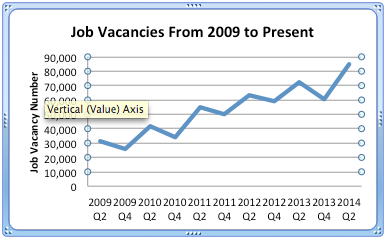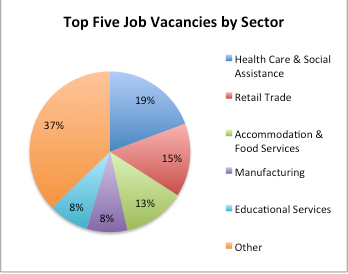By Lindsay Snider
Murphy News Service
Job vacancies in Minnesota have risen to their highest level in 13 years as employers reported nearly 84,700 openings statewide during the second quarter of this year, a state survey shows.
Peak levels of job vacancies can often be associated with employer confidence in the economy, but it can also mean employers are having a tougher time filling open positions, the survey done by the Minnesota Department of Employment and Economic Development (DEED) said.
“During this period employers expected to continue hiring and increasing the work force,” said Oriane Casale, assistant director of the Labor Market Information Office at Minnesota DEED. Casale added that, at the same time, “there’s a much tighter labor market where it’s more difficult for [employers] to find the folks they need.”
Minnesota DEED conducts a Job Vacancy Survey twice each year to measure hiring demand and job vacancy characteristics by sector, occupation and firm size. The information is compiled from 10,000 firms varying in industry and class size around the state.
DEED statistics indicated job openings increased by nearly 17 percent from the same period last year. More than half of these positions were found in the Twin Cities metro area, while the rest were in Greater Minnesota.
While these openings show companies are looking to expand the job market and increase business activity, Casale sees other opportunities for job growth and attractiveness.
The median-wage offer for all job vacancies decreased from $12.50 in the second quarter of 2013 to $12.05 this quarter, DEED results show. The survey also revealed nearly 64 percent of openings require a high school diploma or less, which is up 12 percent from a year ago.
That means the majority of open positions favor low-skill, low-pay occupations.
“Seeing a lower overall median wage offer is not a good thing,” Casale said. “We definitely don’t like to see that.”
One explanation is the occupation mix. The top five industrial divisions with job vacancies include: healthcare and social assistance, retail trade, accommodation and food services, manufacturing and educational services.
“The healthcare sector is typically one of the most vacant,” Casale said. “There’s a much higher increase in the number of support occupation positions than professional and technical positions.” This contributes to the lower wage trend of all occupations, Casale said.
But Casale said she also sees a silver lining in the wage decrease. The high number of open positions in low-wage jobs could mean employees are cycling through more quickly. They could be moving to higher positions.
Casale also noted that certain low-wage occupation sectors, such as retail sales, have a higher median-wage offer than last year. “There may be a positive movement of wages, even though the overall median is lower.”
Raising the median wage is not the only way to improve the job market and attractiveness of open positions. “The number of people who are working part time and are wanting to work full time is still very high compared to prior to the recession,” Casale said.
To incorporate those workers into higher skilled jobs, employers should alter position requirements and look for part-time workers to fill full-time openings, Casale said, adding she believes there are part-time workers qualified enough to fill those positions.
Reporter Lindsay Snider is studying journalism at the University of Minnesota.